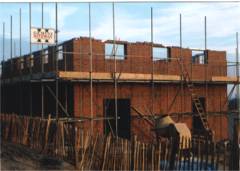The hut served us well for many years, but the Great Storm of 1987 was really the beginning of the end as far as it was concerned. The morning after the storm I arrived to find a large piece of the roof missing, one end wall badly damaged, and the iron ties which supported the roof buckled. The insurance company were very good about it and paid for repairs with no demur.
But it rapidly became apparent that the structure was not as sound as previously.

At first we thought further repairs would suffice, and we had new windows made and fitted along the copse side, now with shutters as a protection against the recurrent vandalism from which we suffered, mainly at weekends. These were a mixed blessing, however, as they shut out not only the drunks but also the sunlight and the warmth it brought to the building, causing further problems with damp. Ceiling panels became loose and fell down, the inner cladding started to deteriorate, and the outer cladding, again with help from malefactors, started to disappear and needed repairing and replacing at an ever faster rate.
In 1992 at the AGM, the decision was taken to start a building fund with a view to erecting a new, purpose-built HQ. Roger Mitchell, the Headmaster, quickly gave his blessing to the idea, and before long fund-raising had started.
Proceeds from paper salvage, which had long been a staple of our finances, were diverted to the new fund, and the long series of boot sales was inaugurated. At first we ran on the car parking area in front of the Lower School, and on the adjacent grass areas. Refreshments were prepared by Glen Russell in one of the classrooms. Then our activities were noticed by Bob Horsley, who owned a hot-dog van, which he brought to the sales. He also used his influence with his circle of acquaintances to increase the number of stalls, until we were soon occupying the whole of the playground and in summer spilling over onto the fields around. We ran once a month for about ten years all together, and at the height of their success the sales were attracting over 100 stalls and raising quite large sums for the fund.

Meanwhile, we sought grant aid from various bodies; here I would like to acknowledge the generous support which we received from, in particular the Isabel Blackman Foundation, who needed no persuasion whatever to support our cause with a very substantial donation; we also received grants from the Hastings Youth Trust and the Lesley Sell Charitable Trust. Catherine Cookson sent a very generous donation. Other friends and supporters contributed large and small amounts, and eventually we had collected nearly £50,000.
Several architects had volunteered their services, and the committee selected a design for the new building by Stuart Rumsey of RDP, whose oldest son was already a member of the Troop. There was some opposition from the neighbours to our building project, who had just seen an end to the disturbance caused to them by the building of the Rugby Club, and we had to overcome their objections to planning permission being granted. Stuart was our main helper in this difficulty. When we started the project, the National Lottery had not been invented, but we realised that our only chance of acquiring sufficient funds to commission the building he had designed was to apply to the Charities Board. Our first application was rejected, but at the second attempt we were successful, and in October 1998 we were able to demolish the hut, so that the ground could be prepared for the contractors, Quadric Ltd., to take possession of the site and begin to lay the foundations.

Naïvely, I had thought that we had done the hard part, and all that remained was to open the new front door and walk in to start our first meeting in the new HQ. This was far from the case. It would be impossible to detail all the various difficulties which beset us during this period. The main problems which spring to mind were the delays the Charities Board seemed to experience making the staged payments to the builders on time; the problems with the access road, which cost several thousand pounds to correct; the VAT office’s decision that we were really a business, and so liable to pay VAT on the construction – this was overturned on appeal; and the way costs seemed to increase in unexpected ways despite hours spent at planning and budgeting meetings.
During the whole rebuilding process we had nowhere of our own to meet, of course, and 1st Hastings kindly made their hall in Oxford Road available to us for our Pack, Troop and Unit meetings. This enabled us to maintain continuity, and was much appreciated, but there is really nowhere like your own place, and we were greatly relieved when the time came, the following autumn, to move back home. Meanwhile, a further unlooked-for complication arose in relation to the store hut. We had put most of our day-to-day equipment in it, as well as the camping gear, but meanwhile it had also suffered further serious damage from the weather and vandalism. It now had to be demolished, as a matter of urgency, before we were really ready. Luckily, the new camp store was about complete, and we were allowed to take possession of it in time to transfer our worldly goods across.
When we moved in towards the end of 1999, there was still a lot to be done to the building, which we had decorated and prepared for use ourselves, during the summer, but lack of funds meant that many items had to wait.
